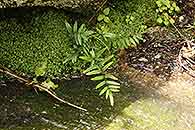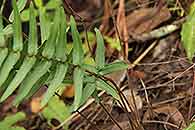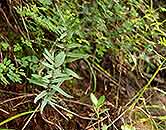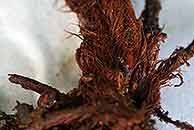Pellaea dura (Willd.) Hook. var. dura
Synonyms |
Pteris dura Willd. |
|---|---|
Common name |
|
Description |
Rhizome shortly creeping to semi-erect, up to 5-7 mm in diameter; rhizome scales linear-lanceolate in outline, apex slowly tapering to a point, subentire, 3-7 mm long, reddish brown. Fronds monomorphic, tufted, erect, 7-50 cm tall, coriaceous. Stipe up to 25 cm long, dark brown, subglabrous with with dense short stiff hairs on upper surface and few hair-like brown scales near the base. Lamina pinnate to 2-pinnate (-3-pinnulate) on the basal 1-3 pinnae, ovate to lanceolate in outline, up to 24 cm × 10 cm; pinnae in 3-10(-22) pairs, narrowly elliptic to lanceolate in outline, apex rounded, cordate to rounded base articulated to a short petiole, 1-7.5(-9) x 0.3-2.5 cm, hairless on both surfaces, paler green below; veins hardly visible and anastomosing; rhachis and secondary rhachises black, with short, soft hairs above, hairless below. Sori marginal, continuous; indusium entire, membranous, continuous. |
Notes | Could be mistaken for P. longipilosa or P. doniana. P. longipilosa has free veins, a more stout stipe and a brown indumentum on stipe and rhachis. P. doniana is never 2-pinnate. |
Derivation | dura: hard, referring to the stiff, coriaceous fronds. |
Habitat | Shaded and moist conditions in rocky woodland and grassland, crevices in rocky slopes. |
Distribution worldwide | Africa, Madagascar, Mascarene and Comoro Islands. |
Distribution in Africa |
Angola, Burundi, Cameroon, Central African Republic, Equatorial Guinea (incl. Bioko), Ethiopia, Gabon, Kenya, Malawi, Mozambique, Namibia, South Africa, Swaziland, Tanzania , Uganda, Zambia, Zimbabwe. |
Growth form |
Lithophytic, terrestrial. |
Literature |
|






